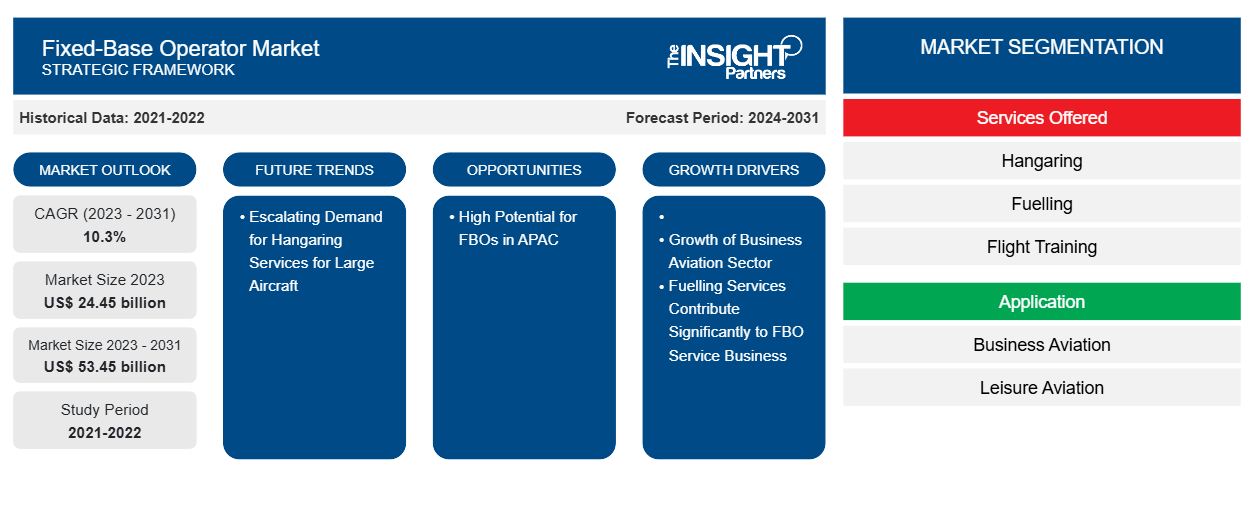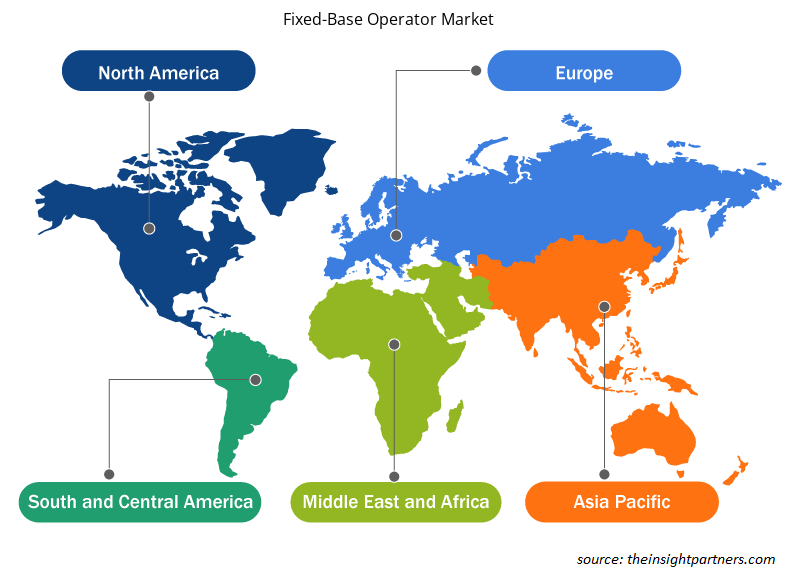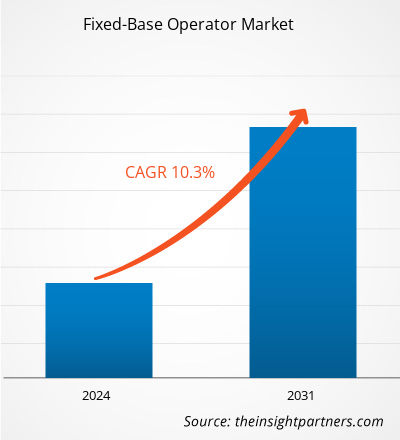Si prevede che il mercato degli operatori di voli fissi raggiungerà i 41,49 miliardi di dollari entro il 2031, rispetto ai 25,55 miliardi di dollari del 2024. Si prevede che il mercato registrerà un CAGR del 7,6% nel periodo 2025-2031. La crescente domanda di servizi di hangar per aeromobili di grandi dimensioni porterà probabilmente nuove tendenze nel mercato nei prossimi anni.
Analisi del mercato degli operatori di telefonia fissa
L'aumento dell'aviazione d'affari e del trasporto passeggeri sta sostenendo la domanda di operatori di trasporto passeggeri (FBO) per offrire diversi servizi ai viaggiatori e migliorare la loro esperienza di viaggio. Il continuo declino del mercato dell'aviazione globale dovuto alla pandemia ha spinto molti operatori di trasporto passeggeri a ridurre i costi e a licenziare personale. Per sopravvivere alla pandemia, i fornitori di servizi di trasporto passeggeri hanno implementato iniziative, tra cui l'espansione dell'attività e la collaborazione con altri operatori di trasporto passeggeri o società di assistenza a terra. Tali iniziative consentono agli operatori del mercato di proseguire la propria attività. La crescita del numero di aeroporti in diverse regioni sta aggiungendo nuove rotte aeree in tutto il mondo, con conseguente aumento della domanda di nuovi operatori di trasporto passeggeri (FBO) nei nuovi aeroporti. Si prevede che la costruzione di nuovi aeroporti greenfield stimolerà la domanda di nuovi operatori di trasporto passeggeri (FBO) in diverse regioni. Inoltre, si prevede che la costruzione in corso dell'aeroporto di Cukurova in Turchia genererà nuove opportunità per i fornitori di servizi di trasporto passeggeri (FBO) durante il periodo di previsione.
Tra i principali fattori che guidano la crescita del mercato FBO a livello mondiale figurano la crescita della flotta di aerei commerciali, l'aumento del traffico passeggeri e l'aumento del numero di aeroporti in tutto il mondo. Secondo l'analisi di Insight Partners, la flotta globale di aerei commerciali ammontava a circa 29.000 velivoli a gennaio 2025, cifra destinata a raggiungere circa 38.300 entro la fine del 2035. Analogamente, il traffico passeggeri aereo globale si è attestato a circa 9,5 miliardi di passeggeri nel 2024, con un aumento di circa il 10% rispetto al traffico passeggeri aereo globale del 2023. Inoltre, il traffico passeggeri aereo del 2024 è stato pari al 104% dei livelli del 2019, a dimostrazione di un pieno recupero anche dei livelli pre-pandemici.
Panoramica del mercato degli operatori di telefonia fissa
L'industria aeronautica globale sta assistendo a un forte aumento della domanda di servizi di hangar per aeromobili di grandi dimensioni, trainato dall'espansione delle dimensioni delle flotte, dall'aumento del numero di jet privati e dalla crescente dipendenza dall'aviazione d'affari. I costruttori di aeromobili per l'aviazione generale stanno sviluppando velivoli di nuova generazione con consumi di carburante ridotti, grandi dimensioni e basse emissioni di rumore e di carbonio. Il design degli hangar viene di conseguenza aggiornato per adattarsi alle mutevoli dimensioni e tecnologie degli aeromobili. Gli hangar moderni vengono dotati di dispositivi di controllo della temperatura e di sicurezza. Secondo Jet Aviation, un importante fornitore di servizi FBO, la necessità di hangar nuovi e più grandi è stata percepita per la prima volta nella regione Asia-Pacifico e l'azienda sta espandendo la sua capacità di fornire servizi di hangar a Singapore e in altri paesi. Gli FBO si stanno concentrando sull'espansione delle dimensioni degli hangar, a causa di situazioni di sovraccapacità. Attendono pazientemente l'annuncio della revisione del codice 409 della National Fire Protection Association (NFPA) relativo agli hangar per l'aviazione. Pertanto, la costruzione di grandi hangar per far fronte al crescente numero di grandi flotte di aerei per l'aviazione generale è una tendenza emergente che sosterrà la crescita del mercato in futuro.
Il divieto ai voli russi dallo spazio aereo dei paesi europei e viceversa, dovuto alla guerra in corso tra Russia e Ucraina, ha ridotto le operazioni aeree nello spazio aereo russo e in altri paesi europei. Questa riduzione sta portando a un calo della domanda di servizi FBO e ostacolando la crescita del mercato nella regione. Anche altre regioni hanno dovuto affrontare diverse tensioni geopolitiche, che stanno ostacolando le operazioni di trasporto aereo in tutto il mondo. Ad esempio, la frattura tra Cina e Taiwan, India e Pakistan, Cina e India, India e Bangladesh e Israele e Gaza rappresenta una delle principali sfide per le operazioni di trasporto aereo a livello globale.
Riceverai la personalizzazione gratuita di qualsiasi report, incluse parti di questo report, analisi a livello nazionale, pacchetto dati Excel e potrai usufruire di fantastiche offerte e sconti per start-up e università.
Mercato degli operatori di telefonia fissa: approfondimenti strategici

-
Scopri le principali tendenze di mercato di questo rapporto.Questo campione GRATUITO includerà analisi di dati che spaziano dalle tendenze di mercato alle stime e alle previsioni.
Driver e opportunità del mercato degli operatori di telefonia fissa
Espansione del settore dell'aviazione d'affari
Gli operatori di base fissi (FBO) svolgono un ruolo cruciale nella gestione di aeromobili e passeggeri, offrendo servizi come rifornimento, manutenzione e pianificazione dei voli. Sono una parte vitale del settore dell'aviazione d'affari, fornendo servizi di terra essenziali all'aviazione privata, aziendale e charter. Con la crescita del settore dell'aviazione d'affari, gli FBO stanno investendo in tecnologia e migliorando le infrastrutture per soddisfare le esigenze in continua evoluzione del settore. Un numero crescente di individui con un elevato patrimonio netto, dirigenti aziendali e imprenditori in Nord America, Europa e Asia-Pacifico ricerca sempre più servizi di aviazione d'affari flessibili e che consentano di risparmiare tempo. Gli FBO offrono un'esperienza fluida ed efficiente agli utenti dell'aviazione d'affari, consentendo loro di concentrarsi sui propri obiettivi aziendali. L'aviazione privata offre viaggi più rapidi tra le città, voli diretti verso aeroporti più piccoli più vicini alle destinazioni ed evita i ritardi delle compagnie aeree commerciali, risparmiando ore di viaggio. Permette inoltre orari flessibili per sfruttare al meglio il tempo. Secondo i dati pubblicati dalla General Aviation Manufacturers Association (GAMA) nel 2023, le consegne di jet privati sono aumentate da 712 nel 2022 a 730 nel 2023. Inoltre, il valore complessivo delle consegne di aerei nel 2023 ha raggiunto i 23,4 miliardi di dollari. Pertanto, l'espansione del settore dell'aviazione privata, dovuta alla crescente domanda di jet privati, sostiene la crescita del mercato.
Elevato potenziale per gli FBO nell'area Asia-Pacifico
L'area Asia-Pacifico (APAC) offre un'elevata opportunità di crescita per gli operatori di terra privati (FBO) grazie alla fiorente aviazione d'affari e al miglioramento delle infrastrutture aeroportuali nella regione. Gli FBO stanno assistendo a un notevole sviluppo in Indonesia, Singapore e Macao per rispondere alla crescente domanda di servizi di terra premium. Attualmente, nei paesi APAC operano 71 FBO; di questi, più di 20 operano in Australia, mentre la Cina continentale ne conta 15. Si prevede che questo numero aumenterà man mano che individui e aziende con un elevato patrimonio netto nei paesi APAC si rivolgono all'aviazione privata per maggiore flessibilità, efficienza e connettività. Pertanto, la necessità di servizi di terra premium sta diventando sempre più evidente, con conseguente aumento della domanda di operatori di base fissi. Molti nuovi aeroporti e ammodernamenti di aeroporti secondari per ospitare l'aviazione generale creano opportunità per gli operatori di FBO, sia internazionali che locali, di entrare o espandersi nel mercato. Secondo i dati pubblicati dall'Association of Asia Pacific Airlines a febbraio 2025, la regione ha registrato una forte crescita nel mercato internazionale del trasporto aereo passeggeri e merci. Asia Pacific Airlines ha trasportato circa 365 milioni di passeggeri internazionali nel 2024, con un aumento del 30,5% rispetto al 2023. Secondo i dati pubblicati da Airbus nel 2024, si prevede che l'area Asia-Pacifico aggiungerà circa 10.000 nuovi aeromobili tra il 2024 e il 2043. Pertanto, l'aumento del traffico aereo nell'area APAC genererà probabilmente opportunità redditizie per il mercato.
Analisi della segmentazione del rapporto di mercato degli operatori di telefonia fissa
I segmenti chiave che contribuiscono all'analisi del mercato degli operatori di base fissa sono i servizi offerti e le applicazioni. In base ai servizi offerti, il mercato degli operatori di base fissa è segmentato in hangar, rifornimento, istruzione di volo, manutenzione aeromobili e noleggio aeromobili. Il segmento del rifornimento ha detenuto la quota di mercato maggiore nel 2024. In base alle applicazioni, il mercato degli operatori di base fissa è segmentato in aviazione d'affari e aviazione da diporto. Il segmento dell'aviazione d'affari ha detenuto una quota di mercato maggiore nel 2024.
Analisi della quota di mercato degli operatori di telefonia fissa per area geografica
L'ambito geografico del rapporto sul mercato degli operatori di voli fissi è suddiviso in cinque regioni principali: Nord America, Europa, Asia-Pacifico, Medio Oriente e Africa e Sud America. Il Nord America ha rappresentato la quota di mercato maggiore, pari al 35,1%, nel 2024 e si prevede che registrerà un CAGR del 6,9% durante il periodo di previsione. L'elevata domanda da parte dei clienti e la diffusa presenza di fornitori di servizi di operatori di voli fissi in Nord America, in particolare negli Stati Uniti, stimolano la crescita del mercato degli operatori di voli fissi. Si prevede che l'area APAC registrerà un'enorme domanda di FBO nei prossimi anni, registrando quindi il CAGR più elevato durante il periodo di previsione; ciò è dovuto alla significativa crescita del segmento dell'aviazione generale, in particolare in Australia, Cina e nei paesi del Sud-est asiatico.
Il Nord America comprende la più grande rete di operatori di voli fissi al mondo. Negli ultimi anni, si è registrata una crescita costante dei voli aziendali e dei voli charter nella regione, con conseguente aumento della domanda di servizi di aviazione generale, come i servizi di operatori di voli fissi. Inoltre, gli Stati Uniti e il Canada ospitano numerosi aeroporti di aviazione generale, il che consente a un numero maggiore di operatori di voli fissi di operare in questi paesi. Ad esempio, l'aeroporto di Teterboro, l'aeroporto di Centennial e l'aeroporto di Van Nuys sono aeroporti chiave con un'elevata concentrazione di operatori di voli fissi. Inoltre, gli Stati Uniti ospitano operatori di voli fissi di fama mondiale come Signature Aviation, Universal Aviation, Jet Aviation, Presidential Aviation e Pentastar Aviation. La notorietà globale di queste aziende consente loro di attrarre clienti da diverse nazioni, catalizzando così i loro ricavi anno dopo anno.
Secondo i dati pubblicati da Airlines for America, nel 2023 l'aviazione commerciale rappresentava il 5% del PIL statunitense, ovvero 1,37 trilioni di dollari. Inoltre, l'aumento del traffico passeggeri e le iniziative governative volte ad ampliare le flotte di aeromobili nel settore dell'aviazione commerciale alimentano la domanda di soluzioni per la gestione del volo, come i software di pianificazione.
L'Europa detiene la seconda quota di mercato mondiale degli operatori di voli fissi. La presenza di operatori di primo piano, come Gama Aviation Plc., Lufthansa Technik FBO e Luxaviation, è un fattore chiave che guida la crescita del mercato in Europa. Inoltre, la costante crescita dell'aviazione generale nella regione sta aumentando l'utilizzo da parte dei viaggiatori di jet privati/business jet, per un'esperienza di viaggio migliore. L'aviazione generale comprende aeromobili che vanno dagli alianti ai jet privati più complessi, con una gamma completa di servizi di alto valore, come gli FBO e il trasporto aziendale door-to-door. Le tendenze in Europa si stanno spostando verso la necessità di promuovere innovazione e ricerca per ridurre l'impatto ambientale.Plc., Lufthansa Technik FBO, and Luxaviation, is a key factor driving the market growth in Europe. Further, the constant growth of general aviation in the region is increasing the traveler's footprint on business jets/private jets for enhanced travel experience. General aviation comprises aircraft ranging from gliders to complex business jets with a complete range of high-value services, such as FBOs and business door-to-door transportation. The trends in Europe are shifting toward the need to carry out innovation and research to reduce environmental impacts.
Nella regione Asia-Pacifico, il mercato degli operatori di voli fissi è dominato dall'Australia e dai paesi del Sud-est asiatico. Entro il 2039, si prevede che l'aeroporto di Sydney gestirà oltre 65 milioni di passeggeri – oltre 408.000 movimenti aeroportuali – e 1 milione di tonnellate di merci all'anno. Il governo ha stanziato 8,4 miliardi di dollari dal 2022 al 2026 per lo sviluppo dell'aeroporto di Sydney Ovest. La sostenibilità rimane un punto focale, con gli aeroporti che integrano pratiche ecocompatibili e fonti di energia rinnovabile nelle proprie infrastrutture. La crescente domanda di aviazione d'affari, insieme all'aumento del reddito disponibile, sta creando opportunità di crescita per le aziende che operano nel mercato in questi paesi. Nel Sud-est asiatico, vi è una forte presenza di reti di operatori di voli fissi, e la domanda di aviazione d'affari e di piacere è elevata anche in paesi come Singapore, Indonesia, Filippine e Malesia. Con la crescente domanda di servizi di aviazione d'affari per migliorare l'esperienza di viaggio in questi paesi, l'adozione di operatori di voli fissi è in aumento. Nella regione Asia-Pacifico, la crescita del mercato è stata attribuita principalmente all'espansione delle flotte aeree e allo sviluppo delle infrastrutture aeroportuali. L'International Air Transport Association ha previsto che entro il 2036 si sposteranno 2,1 miliardi di viaggiatori, in particolare in Cina. Si prevede che il crescente numero di passeggeri alimenterà la domanda di servizi di trasporto aereo a base fissa. Si prevede che questo fattore creerà opportunità di crescita per i principali operatori che operano sul mercato durante il periodo di previsione.
Approfondimenti regionali sul mercato degli operatori di telefonia fissa
Le tendenze e i fattori regionali che influenzano il mercato degli operatori di telefonia fissa durante il periodo di previsione sono stati ampiamente illustrati dagli analisti di Insight Partners. Questa sezione illustra anche i segmenti e la geografia del mercato degli operatori di telefonia fissa in Nord America, Europa, Asia-Pacifico, Medio Oriente e Africa, e Sud e Centro America.

- Ottieni i dati specifici regionali per il mercato degli operatori di telefonia fissa
Ambito del rapporto sul mercato degli operatori di telefonia fissa
| Attributo del report | Dettagli |
|---|---|
| Dimensioni del mercato nel 2024 | 25,55 miliardi di dollari USA |
| Dimensioni del mercato entro il 2031 | 41,49 miliardi di dollari USA |
| CAGR globale (2025-2031) | 7,6% |
| Dati storici | 2021-2023 |
| Periodo di previsione | 2025-2031 |
| Segmenti coperti |
Per servizi offerti
|
| Regioni e paesi coperti |
America del Nord
|
| Leader di mercato e profili aziendali chiave |
|
Densità degli operatori di mercato di telefonia fissa: comprendere il suo impatto sulle dinamiche aziendali
Il mercato degli operatori di telefonia fissa è in rapida crescita, trainato dalla crescente domanda degli utenti finali, dovuta a fattori quali l'evoluzione delle preferenze dei consumatori, i progressi tecnologici e una maggiore consapevolezza dei vantaggi del prodotto. Con l'aumento della domanda, le aziende stanno ampliando la propria offerta, innovando per soddisfare le esigenze dei consumatori e sfruttando le tendenze emergenti, alimentando ulteriormente la crescita del mercato.
La densità degli operatori di mercato si riferisce alla distribuzione delle imprese che operano in un determinato mercato o settore. Indica quanti concorrenti (operatori di mercato) sono presenti in un determinato spazio di mercato in relazione alle sue dimensioni o al suo valore totale.
Le principali aziende che operano nel mercato degli operatori di telefonia fissa sono:
- Avemex SA De CV
- DEER JET CO. LTD.
- dnata
- General Dynamics Corp
- Jetex
- Luxaviation
Disclaimer : le aziende elencate sopra non sono classificate secondo alcun ordine particolare.

- Ottieni una panoramica dei principali attori del mercato degli operatori di telefonia fissa
Notizie e sviluppi recenti del mercato degli operatori di telefonia fissa
Il mercato degli operatori di telefonia fissa viene valutato raccogliendo dati qualitativi e quantitativi a seguito di ricerche primarie e secondarie, che includono importanti pubblicazioni aziendali, dati di associazioni e database. Di seguito sono elencati alcuni degli sviluppi nel mercato degli operatori di telefonia fissa:
- Atlantic Aviation ha annunciato l'acquisizione di Ferrovial Vertipors da Ferrovial, azienda leader mondiale nel settore delle infrastrutture. (Atlantic Aviation, comunicato stampa, 2025)
- L'Air Charter Safety Foundation (ACSF) è orgogliosa di annunciare che Avemex SA de CV ha rinnovato con successo la sua registrazione Industry Audit Standard (IAS), consolidando il suo impegno per il massimo livello di sicurezza nel settore dell'aviazione. (Air Charter Safety Foundation, Comunicato stampa, 2024)
Copertura e risultati del rapporto sul mercato degli operatori di telefonia fissa
Il rapporto "Dimensioni e previsioni del mercato degli operatori di telefonia fissa (2021-2031)" fornisce un'analisi dettagliata del mercato che copre le seguenti aree:
- Dimensioni e previsioni del mercato degli operatori di telefonia fissa a livello globale, regionale e nazionale per tutti i principali segmenti di mercato coperti dall'ambito
- Tendenze del mercato degli operatori di base fissa, nonché dinamiche di mercato quali driver, vincoli e opportunità chiave
- Analisi dettagliata delle cinque forze di Porter e analisi SWOT
- Analisi del mercato degli operatori di telefonia fissa che copre le principali tendenze del mercato, il quadro globale e regionale, i principali attori, le normative e i recenti sviluppi del mercato
- Analisi del panorama industriale e della concorrenza che copre la concentrazione del mercato, l'analisi della mappa di calore, l'analisi della quota di mercato dei principali attori e gli sviluppi recenti per il mercato degli operatori di telefonia fissa
- Profili aziendali dettagliati
- Analisi storica (2 anni), anno base, previsione (7 anni) con CAGR
- Analisi PEST e SWOT
- Valore/volume delle dimensioni del mercato - Globale, Regionale, Nazionale
- Industria e panorama competitivo
- Set di dati Excel
Report recenti
Testimonianze
Motivo dell'acquisto
- Processo decisionale informato
- Comprensione delle dinamiche di mercato
- Analisi competitiva
- Analisi dei clienti
- Previsioni di mercato
- Mitigazione del rischio
- Pianificazione strategica
- Giustificazione degli investimenti
- Identificazione dei mercati emergenti
- Miglioramento delle strategie di marketing
- Aumento dell'efficienza operativa
- Allineamento alle tendenze normative






















 Ottieni un campione gratuito per - Mercato degli operatori di telefonia fissa
Ottieni un campione gratuito per - Mercato degli operatori di telefonia fissa